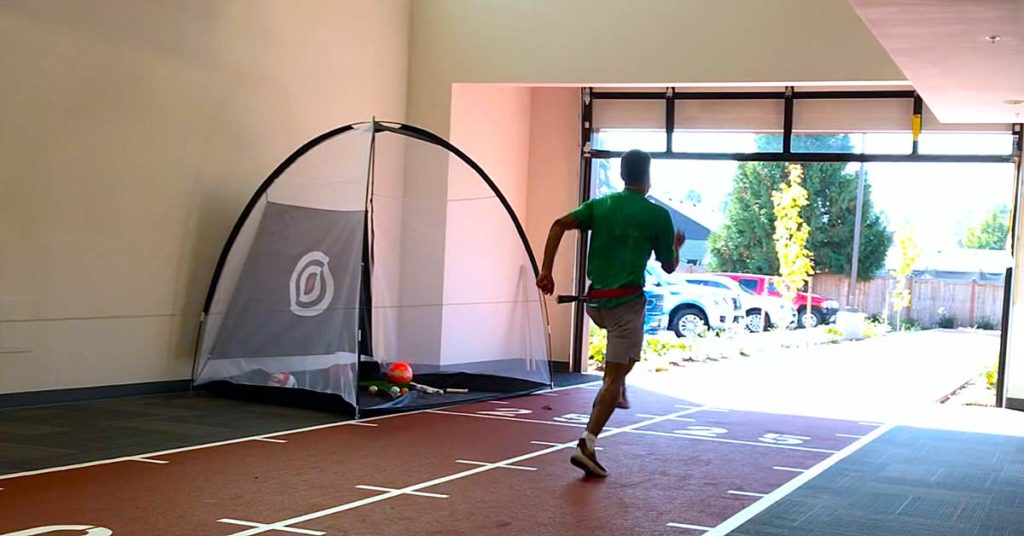
When I played college football, we did a LOT of resisted sprints via sled pushes, but they were always used as a conditioning tool in the circuits at the end of our workouts. We did not push sleds as a “main lift” or with the goal of improving sprint performance or overall power.
We probably left some performance gains on the table as a result.
In fairness, my college days were nearly a decade ago, before JB Morin and the group he leads published their research surrounding resisted sprints. JB and the gang did what scientists do and made a science out of resisted sprints. Their research elucidated the underpinning mechanisms of performance improvement and highlighted nontraditional methods of utilizing resisted sprints. They also popularized a common language by which to discuss resisted sprints and addressed common flaws in programming them, leading us to understand how and why they induce specific adaptations when specific loads are used.
I discuss four unique uses of resisted sprints in this article, each with a different purpose and different adaptation(s). Before diving in, however, let’s briefly overview the language of resisted sprints so we’re on the same page moving forward.
Performance Variables
I won’t belabor each of the variables measured in the research. Instead, I’ll provide definitions for the ones discussed in this article.
For a more complete list, see this article.1
Pmax (W/kg): maximum mechanical power output. In this article, I use the term to describe the maximum power achieved while sprinting.
V0 (m/s): theoretical maximal running velocity as extrapolated from the force-velocity relationship. Basically, the predicted max speed of an athlete based on their force-velocity profile. Note this figure is slightly higher than an athlete’s actual maximum running velocity.
F0 (N/kg): theoretical maximal horizontal force production as extrapolated from the force-velocity relationship. Liken this to low-velocity or maximum strength. F0 corresponds well with starting speed and early acceleration, as these aspects of a sprint are heavily dependent on raw force production capacity. It is also of note for collision sports in which athletes need to exert force onto one another, such as American football or rugby.
RF (%): Ratio of force, computed as the ratio of the step-averaged horizontal component of the ground-reaction force to the corresponding resultant force. Put simply, this measures how effectively an athlete is able to orient their forces horizontally versus vertically during acceleration. Of course, the more horizontal (forward) forces are oriented, the faster and more efficiently an athlete accelerates.
RFmax (%): Maximal value of RF. Practically speaking, this describes an athlete’s effectiveness in orienting forces horizontally during the first step, assuming they have a basic technical competency of acceleration, and the first step is when the projection angle is steepest.
Drf : Rate of decrease in RF as speed increases. As athletes rise during acceleration, forces inevitably become more and more vertical until, by definition, at maximum speed net horizontal forces are zero (meaning horizontal propulsive and braking forces are equal), and the resultant GRF is completely vertical. Effective acceleration involves elongating the unavoidable shift toward vertically oriented forces. This metric measures that shift.
Vdec (%): Decrement in sprint velocity (thanks to resistance) as a percentage of maximum velocity. A Vdec of 25% means an athlete is towing a resistance that decreases their max speed by 25%, for instance.
Prescribing Load: Vdec vs. % Body Weight
Much of the research on resisted sprints has involved load prescription based on a percentage of the athlete’s body weight. While this may make sense at first glance, when you take a deeper look, the pitfalls become blatant.
Much of the research on resisted sprints has involved load prescription based on a % of athlete body weight. This makes sense at first glance, but when you look deeper, the pitfalls become blatant. Share on XWhat surface was the sled on? Turf, carpet, and hardwood all feel very different.
What material was on the feet of the sled? The facility I trained at in college put carpet on the feet because the surface was an old basketball court. While we’re on the topic—does the sled have feet or wheels?
What if athletes are super lean or overweight? If using a percentage of body weight, that affects the training load significantly.
Likewise, what if athletes of the same body weight have very different strength levels? The training stimulus will be very different between them.
And the list goes on.
The bottom line is the percentage method doesn’t account for friction or control for the intensity of the exercise. It is not a good way to prescribe load for resisted sprints.
The bottom line is the percentage method doesn’t account for friction or control for the intensity of the exercise. It’s not a good way to prescribe load for resisted sprints, says @KD_KyleDavey. Share on XThat’s where Vdec comes in to save the day. Vdec controls for friction and intensity.
Say you prescribe a back squat load that limits the concentric portion to 5% of the athlete’s max unweighted squat speed. Said opposite, the weight slows them down by 95%. This will be a near maximal effort for all athletes.
But if you instead had every athlete put 120% of their body weight on the bar, some athletes may be maxing out while others are warming up. By the same reasoning, it doesn’t make any sense to prescribe resisted sprint load based on body weight. Vdec makes it proportional to your ability and is not affected by outside factors like surface, type of sled, etc.
To determine the load required for each desired Vdec percentage you have to run a load-velocity profiling. This takes seconds to do on the 1080 Sprint, thanks to the handy software that comes with the unit. Otherwise, you have to have accurate timing or speed measurement tools, the ability to extract the data, and some data analysis skills.
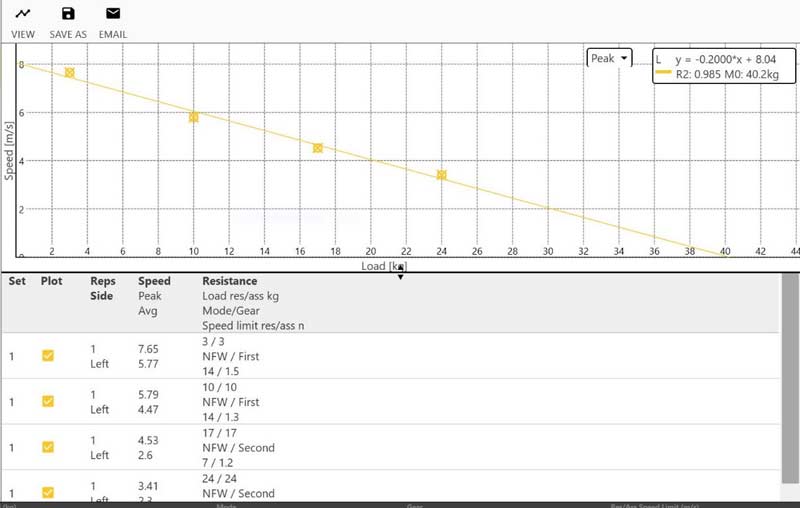
Now that we’ve got the basics out of the way, let’s move on to the good stuff: application.
Post-Activation Potentiation
Post-activation potentiation (PAP) describes a phenomenon by which maximal or near maximal efforts (in terms of intensity) improve performance in submaximal efforts (again in terms of intensity).
French contrast training has popularized PAP in the gym. Put simply, the idea is that doing a few reps of a heavy lift gives a little boost to your explosive ability. A typical weight room combo is a heavy back squat followed by a plyo, like a box jump. With greater jump performance comes a greater training stimulus, and thus a greater cumulative training result.
On the track (or turf), we can use resisted sprints to apply the PAP principle to potentiate the nervous system for the upcoming speed workout. It makes sense in my mind to use this method on acceleration-based days, but potentiating the nervous system on a max velocity day doesn’t sound like a bad idea either. Not that I need to explain why faster sprints are important, but…whether it’s a testing day or a training day, running faster is a good thing.
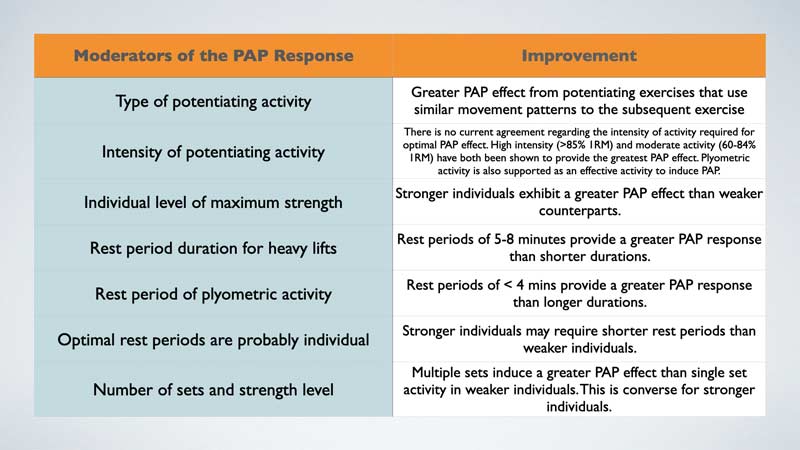
The jury is out on the best resistance to use. The classic understanding would dictate that you implement very heavy resistance, but in practice I know many coaches prefer a lighter one. My advice? Run your own case study. Try both and see which works best for your athletes (and for you).
The classic understanding would dictate that you implement very heavy resistance, but in practice I know many coaches prefer a lighter one, says @KD_KyleDavey. Share on XA simple method to accomplish this is to use the same training protocol but a different PAP stimulus over two training sessions. Begin each session with a timed free sprint, introduce the PAP stimulus, and time athletes’ subsequent sprints to see which stimulus elicits a greater performance. On day one a higher Vdec can be used, say 60-70%, and on day two a lower one, like 20-30%.
You may find some athletes respond better to one method versus another. Be sure to note which stimulus is most effective for each individual athlete so you know what load to give them on future training days.
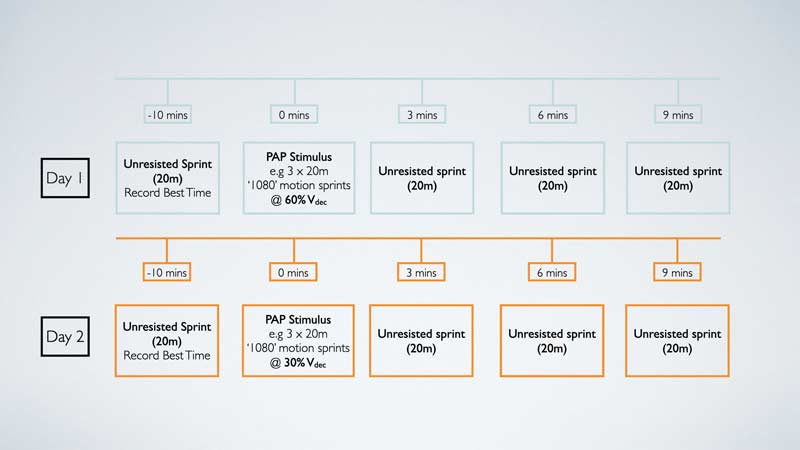
Further, use your coach’s intellect and intuition. If an athlete comes in particularly tired, maybe going nuts with a super heavy resisted sprint isn’t a wise move. Instead, you can use a 10% or 20% Vdec to elicit a response without crushing the athlete, or maybe you switch gears and go to a plan B workout, skipping the resisted sprints altogether.
However, if it is a good day and PAP is a go, there are several ways to work it into the session. You can simply begin the workout with a few 10-meter resisted sprints, or you can integrate them into your rep/set scheme.
Below are three examples of workouts utilizing the PAP principle.
Workout 1: Frontloaded PAP
- Dynamic warm-up + sprint drills
- Three 10-meter resisted sprints, 2-3 minutes of rest between reps
- Three sets of:
- Three 10s, 60 seconds of rest between reps
- Two 20s, 90 seconds of rest between reps
- One 30
- Four minutes of rest between sets
Workout 2: Integrated PAP
- Dynamic warm-up + sprint drills
- Five sets of:
- One 10-meter resisted sprint, two minutes of rest
- One 20-meter sprint, 90 seconds of rest
- One 30-meter sprint
- Four minutes of rest between sets
Workout 3: 1080 Sprint Variable Resistance Accelerations
- Dynamic warm-up + sprint drills
- Six sets of:
- One 30-meter variable resistance sprint, 15 kilograms to 3 kilograms, 3 minutes of rest
- One unresisted 30-meter sprint
- Three minutes of rest between sets
The 1080 Sprint’s variable resistance setting provides both a unique sensation and method of harnessing PAP within the rep itself. The setting allows you to select the resistances you’d like at the start of the sprint and when the athlete reaches a velocity of your choice, and it adjusts linearly as velocity changes.
In plain English: As the athlete speeds up, the resistance decreases (or increases, if you want, but in this case, we’re setting it to decrease). That way, athletes start the sprint against a lot of resistance, and as they accelerate there is less and less weight to tow until they are towing nearly nothing at all (if you set it that low). This is great because it prompts athletes to be forceful in the start and early acceleration, which is exactly what we want during free sprints.
Video 1. Athlete sprints with variable resistance from the 1080 Sprint.
As an aside, unless it is a test day, I usually prefer integrating resisted sprints into the set (workouts 2 and 3) rather than using them as a primer in the beginning of the workout. My bias is that there is likely better transference of force application when alternating between resisted and unresisted sprints. However, this statement comes from a place of developing physical qualities more so than preparing technically and tactically for an actual race, so take it with a grain of salt.
In terms of technique, however, I have noticed many athletes stumble on their first free sprint after a resisted sprint because they’ve just become accustomed to projecting at an exaggerated angle, knowing the resistance (the belt from the 1080 Sprint, in my case) will hold them up.
I use this as an opportunity to teach athletes to find the boundary of how steep they can attack before falling on their face. Once they find the boundary, they can toe it to have the best starting angle possible, resulting in an increased RFmax and more time spent orienting forces horizontally during the acceleration. Hopefully the combination of becoming comfortable in a horizontal position and increasing raw power will also allow for a lower Drf, meaning more time spent orienting forces horizontally down the track or field. That is conjecture at this point.
For a more detailed review of PAP and resisted sprints, I highly encourage you to check out George Petrakos’ article “Resisted Sprints and Post-Activation Potentiation.”
Strength Training: Increased Force Production
I considered titling this section “Improving Starting Speed and Early Acceleration: Very Heavy Resistance.” However, I’m aware that heavy resisted sprints have been a point of contention for years, and I’d prefer your eyes remain on the screen rather than rolling in the back of your head. Hear me out.
The main criticism of very heavy resisted sprints—I’m talking Vdec of 60% and above—is that they screw up unresisted sprint kinematics. To my knowledge this has been assessed only once in the literature, and there were no kinematic changes on free sprints following a training protocol of very heavy sled pulls.2 Yes, mechanics change slightly during the resisted sprint itself, but who cares if it doesn’t affect unresisted sprint mechanics?
Furthermore, variability in movement patterns/strategies is likely a good thing for athletes, not a bad one.
With that said, allow me to add a caveat. It is my belief that free sprint mechanics are not negatively affected by very heavy resisted sprints so long as the basic principles of acceleration are maintained during the resisted sprints.
It is my belief that free sprint mechanics are not negatively affected by very heavy resisted sprints so long as the basic principles of acceleration are maintained during the resisted sprints. Share on XVery heavy resistance can cause athletes to make some critical technical errors, like letting the heel hit the ground upon contact and relying on a frequency-based strategy instead of a strategy based in long ground contacts that allow for a strong push.
In other words, athletes can revert to poor ankle/foot stiffness and spinning the wheels. A good coach will catch this and train athletes out of these patterns. Under these circumstances, I believe there is no negative transference to free sprints, and in fact there may be mechanical benefits, discussed later in this article.
Videos 2a & 2b. Video 2a shows an athlete relying on a “spin the wheels” strategy, followed by an appropriate sprint pattern with very heavy resistance in Video 2b.
Video 3. Heavy resisted marches, shown here, is a drill that helps teach athletes how to push rather than spin the wheels. Athletes may take one step at a time or two, both shown above. I found the two-step method easier on the 1080 than the sled, but it can be done on either.
In any case, I view very heavy resisted sprints NOT as sprint training, but as STRENGTH training. I’m a fan of Anatoliy Bondarchuk’s exercise classification hierarchy.
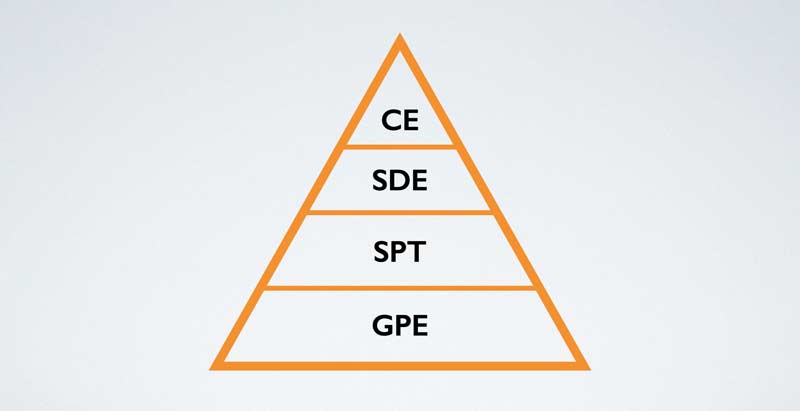
A very heavy resisted sprint is both a specific development exercise, meaning similar to but not the same as free sprinting, and a specific preparatory exercise, meaning it develops the same physiological systems required by and used during free sprinting. Shifting your perception opens your mind here.
While not the only factor that contributes to speed, force production is of course a key component. Specifically, starting speed and early acceleration are heavily influenced by an athlete’s maximal force production capacity, F0. Very heavy resisted sprints increase F0. What’s more, and perhaps surprising, is that very heavy resisted sprints have also been shown to increase V0.3
Yes, you read that correctly: Very heavy sled training (Vdec of 75-85% in the referenced study) can increase max velocity. But, in general, I consider very heavy resisted sprints most applicable to starting speed and early acceleration.
When talking with athletes, I speak their language. Rather than saying “your 5- and 10-meter time will decrease,” I go with “your explosive speed will get upgraded.” Every athlete knows what explosiveness is, but not all have an emotional attachment to a 5-meter split time.
If you’ve got the means to perform force-velocity profiles on your athletes, heavy resisted sprints could be a game changer for you, says @KD_KyleDavey. Share on XIf you’ve got the means to perform force-velocity profiles on your athletes, heavy resisted sprints could be a game changer for you. The works of JB Morin, Pierre Samozino, and the rest of the gang have brought to light that force-deficient athletes—those whose speed would benefit most from gaining absolute strength (improving F0)—particularly benefit from very heavy resisted sprints. No surprise there. If you can identify which athletes in your group need this particular type of training, the specificity of training you administer jumps up a notch, and so do your results.
Maximum Power Development
In my mind, it is power, not strength, that is an athlete’s engine. Recall the formulas:
Work = force * displacement
Power = work/time OR force * velocity
Power basically measures how fast an athlete can get from point A to point B with a given weight. In terms of sprinting, the weight is your body weight. Assuming body weight stays constant, the faster you are, the more powerful you are.
Said backward: The more powerful you are, the faster you are.
Yes, I understand there is more to speed than JUST being powerful, and it is not always the most powerful athlete who wins the race. But it would be foolish not to recognize the tremendous influence power has toward acceleration and maximum speed. Accordingly, developing power should be of high interest for the strength and conditioning coach and athlete alike.
During a free sprint, athletes typically achieve maximum power (Pmax) within one second, and the rest of the sprint occurs at velocities too high to generate maximum power. This is where resisted sprints come in.
A 2016 paper by Matt Cross et al. titled “Optimal Loading for Maximizing Power During Sled-Resisted Sprinting”3changed the game. The paper defined, for the first time, how to prescribe resisted sprints such that the athlete is at Pmax throughout the sprint. Rather than only achieving Pmax for one step during a free sprint, athletes can achieve Pmax with every step, significantly changing the training stimulus.
What’s the secret? The resistance has to induce a Vdec of 48-52%. In practice, I run a load-velocity profiling (which takes seconds with the 1080 Sprint) and choose the resistance that cuts the athlete’s max speed in half, a 50% Vdec. This resistance is known as the “optimal load.”
Video 4. An athlete sprinting against a load that induces a 50% Vdec, the prescription for sprinting at Pmax.
What are the benefits of training at max power? Well…improving max power. This is not the only method of doing so, but it is a good one, and certainly the most specific for sprinting.
The 1080 Sprint displays the power of each rep immediately upon completion. (I swear I’m not a 1080 salesman, I just love the product. However, Peter—if you’re reading—I will accept a royalty!) To drive competition and motivation, my athletes write their individual power record—the “most powerful sprint” in the table below—on a giant mirror in the training space and make that the number to beat, knowing the only way to do so is for them to improve their sprint time against the optimal load. Athletes LOVE chasing their number and breaking their record, and I always post a celebratory picture on our social media account when they do so.
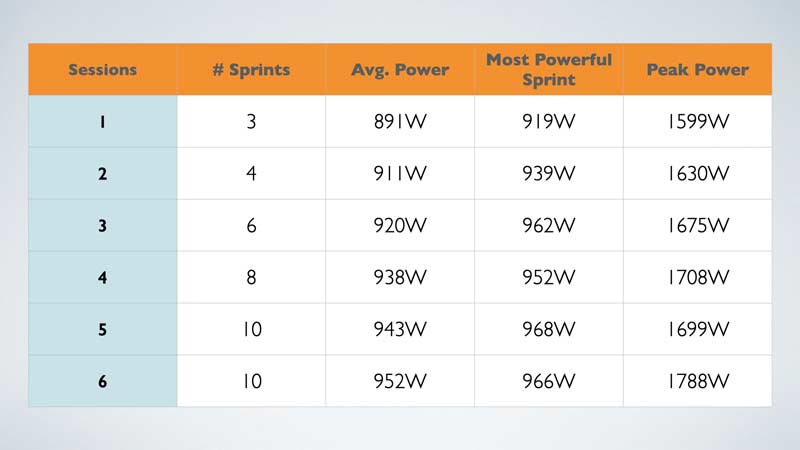
In the training summary above, notice that average power increases with each session (despite reps also increasing), and the most powerful sprint as well as peak power trend upward as well. Comparing session six to session one, average sprint power increased 6.9%, the most powerful sprint showed a 5.1% in power, and peak power increased 11.8%. This athlete’s 30-meter sprint time also dropped 0.11 seconds over the three and half months we trained. Granted, his training consisted of more than resisted sprints, but I believe they were an important piece of the puzzle.
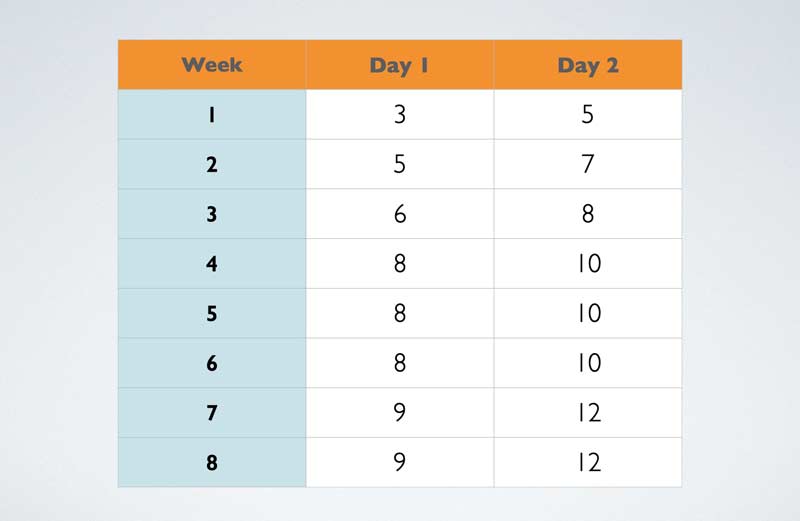
A few words of caution.
While resisted sprints can be a great medium for teaching an athlete to project at a strong angle, they do not allow an athlete to experience the rise in posture associated with a free sprint. Due to the resistance limiting speed, and the need to orient forces horizontally to move against the weight, the athlete is essentially stuck in an acceleration posture and does not reach a transition or max speed phase. As such, you may need to take extra time to teach the gradual rise to a proper, upright, max velocity posture.
While sprinting against resistance will not look exactly the same as sprinting without it, you should apply and maintain the same technical model, says @KD_KyleDavey. Share on XFurther, if you use this protocol with enough athletes, you will notice all kinds of deviations from ideal acceleration posture: exaggerated lateral movements of the head, arms, hips, and feet; excessive rounding of the upper back (particularly if a belt is used versus a harness); poor knee drive, resulting in a “spinning the wheels” action and poor ankle and foot stiffness, as discussed above; excessive cervical flexion or extension; and likely others I’m either forgetting or haven’t seen yet. It could be that resistance amplifies existing technical errors, making them easier to spot, but that’s pure conjecture. Either way, while sprinting against resistance will not look exactly the same as sprinting without it, you should apply and maintain the same technical model.
Don’t let your athletes look like dog crap just because they’re towing weight.
For another look at sprint training at max power, I highly recommend a brilliant piece by Cam Josse, “Maximum Power Sled Sprinting for American Football.”
Max Speed Development
Most of the talk around resisted sprints is about acceleration. Rightfully so, as they certainly improve acceleration abilities. But I believe there is also application toward improving maximum velocity.
Not disregarding the importance of vertical force production, what doesn’t get discussed as much is horizontal force as a contributor to max velocity. By definition, maximum velocity is reached when net horizontal forces are zero, meaning braking and propulsion are equal. Hence, propulsive horizontal force is a driver of maximum velocity. Indeed, elite sprinters produce more net horizontal force and impulse at any given velocity than sub-elite sprinters4-6, which allows them to attain higher maximum velocities.7
Not disregarding the importance of vertical force production, what doesn’t get discussed as much is horizontal force as a contributor to max velocity, says @KD_KyleDavey. Share on XMaybe I’m reading the vibe wrong, but it seems like discussing horizontal forces at top speed is akin to promoting backside mechanics, and is thus taboo. Even if some folks indeed do lump those two concepts together, of course we can discuss horizontal forces without simultaneously promoting backside mechanics.
Here’s what I’m getting at: Very light resistance, say a Vdec of 5-10%, allows an athlete to reach near maximal velocity (90-95% of max speed, by definition) while prompting them to produce more horizontal forces at those speeds. You can see how such a stimulus could induce greater force production at those near maximal speeds. I don’t have a systematic review to cite here, but my brain tells me that if training adaptations include more force production at a near max velocity, then the athlete’s max velocity will increase.
Video 5. An athlete sprinting against a resistance that induces a Vdec of roughly 5%.
In weightlifting terms, if what used to be my 2RM is now my 5RM, my 1RM has likely increased. If X velocity used to require 90% of my force production capacity and now only requires 80%, maximum speed has surely increased as well.
I’m doing nothing more than channeling an old training concept here. One way to increase performance at a given weight is to train slightly above and slightly below that weight. Very light resistance takes one side of that equation and overspeed training takes the other.
Returning to the backside mechanics discussion—to prove I’m not promoting witchcraft and blasphemy—it’s helpful to compare film of a free run versus a run with very light resistance to ensure kinematics indeed are not shifting out of the desired bandwidth. Unlike very heavy and max power sprints, where I’m more comfortable fudging archetypal kinematics in order to achieve an adaption, this training modality is best used to train force production while using pristine kinematics. Accordingly, I don’t want technique to change much at all when towing a very light resistance.
As with PAP, I think there are a few ways to integrate this into your training sessions. Pairing a very light resisted fly run with an unresisted one is a good way of doing so.
If you’ve been following along closely, you’ll note that aside from the PAP discussion, we’ve analyzed the use and efficacy of resisted sprints at descending intensities: very heavy, moderately heavy, and light resistance. Each provides a very unique training stimulus—just like very heavy, moderately heavy, and light squats do—and these stimuli need to be understood and implemented carefully to achieve a targeted outcome.
Is your athlete force-deficient? Very heavy sleds will help.
Is it a power training block? Max power sprints are the way to go.
And if your goal is to improve max speed, very light resistance may be helpful.
Resisted sprints are not magical, nor are they the holy grail. They are like every other training modality: a stimulus.
Know the goal and implement training methods accordingly.
Since you’re here…
…we have a small favor to ask. More people are reading SimpliFaster than ever, and each week we bring you compelling content from coaches, sport scientists, and physiotherapists who are devoted to building better athletes. Please take a moment to share the articles on social media, engage the authors with questions and comments below, and link to articles when appropriate if you have a blog or participate on forums of related topics. — SF
References
1. Morin, J. B. and Samozino, P. “Interpreting power-force-velocity profiles for individualized and specific training.” International Journal of Sports Physiology and Performance. 2016;11(2):267-272.
2. Lahti, J., Huuhka, T., Romero, V., Bezodis, I. N., Morin, J., and Hakkinen, K. “Changes in sprint performance and sagittal plane kinematics after heavy resisted 20 sprint training in professional soccer players.” Pre-print, 2019.
3. Cross, M. R., Brughelli, M., Samozino, P., Brown, S. R., and Morin, J. B. “Optimal loading for maximizing power during sled-resisted sprinting.”International Journal of Sports Physiology and Performance. 2017;12(8):1069-1077.
4. Morin, J. B., Bourdin, M., Edouard, P., Peyrot, N., Samozino, P., and Lacour, J. R. “Mechanical determinants of 100-m sprint running performance.”European Journal of Applied Physiology. 2012;112(11):3921-3930.
5. Morin, J. B., Edouard, P., and Samozino, P. “Technical ability of force application as a determinant factor of sprint performance.”Medicine and Science in Sports and Exercise. 2011;43(9):1680-1688.
6. Rabita, G., Dorel, S., Slawinski, J., Sàez‐de‐Villarreal, E., Couturier, A., Samozino, P., and Morin, J. B. “Sprint mechanics in world‐class athletes: a new insight into the limits of human locomotion.”Scandinavian Journal of Medicine & Science in Sports. 2015;25(5):583-594.
7. Hicks, D. S., Schuster, J. G., Samozino, P., and Morin, J. B. “Improving Mechanical Effectiveness During Sprint Acceleration: Practical Recommendations and Guidelines.”Strength & Conditioning Journal. 2020;42(2):45-62.


Thanks Kyle for the clear and comprehensive synthesis 👍
Thank you JB! Means a lot coming from you. Thank you for your contributions to the field.